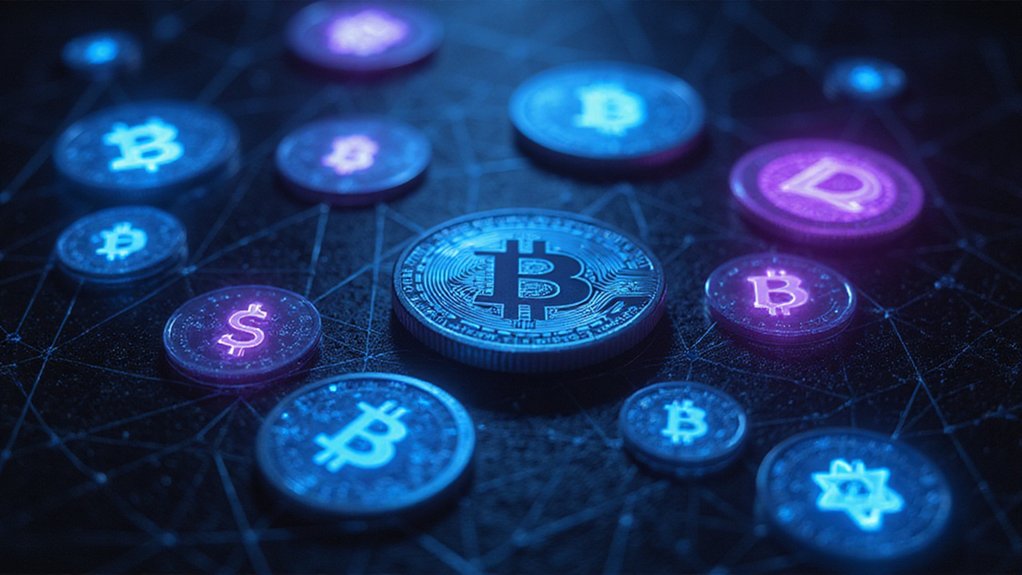Circulating supply represents cryptocurrency tokens freely available for trading, excluding those locked in vesting schedules or reserved by institutions. Unlike total supply (all coins ever created), this metric reflects what’s actually moving in markets and serves as the basis for market capitalization calculations. Bitcoin’s 19 million circulating coins (of 21 million total) exemplifies this distinction. Various factors—mining protocols, burn mechanisms, exchange listings—continuously influence this figure, making it both compass and barometer for savvy investors traversing crypto’s peculiar economic landscape.

What exactly determines a cryptocurrency’s true market footprint in the vast digital economy?
The answer lies largely in its circulating supply—those coins or tokens freely available for trading, unencumbered by developer lockups or institutional reservations.
This fluctuating metric serves as the foundation for evaluating a digital asset’s market presence and, by extension, its relative significance in the increasingly crowded cryptocurrency landscape.
Unlike total supply (which encompasses all existing coins regardless of availability), circulating supply reflects only what’s actually moving through the market ecosystem.
The distinction proves essential; a project might boast an impressive total supply while maintaining artificially restricted circulation—a nuance that savvy investors scrutinize before committing capital.
This disparity often explains why nascent cryptocurrencies can display seemingly inflated valuations despite limited adoption.¹
The calculation of market capitalization—that oft-cited measure of cryptocurrency prominence—depends fundamentally on circulating supply.
When Bitcoin’s approximately 19 million circulating coins trade at $21,000 each, the resulting $399 billion market cap represents the collective valuation assigned by market participants.
(And yet, how curious that this figure can fluctuate by billions based on mining outputs, exchange listings, or regulatory interventions.)
Multiple factors influence circulating supply dynamics.
Mining and minting protocols introduce new coins, while vesting schedules and strategic lock-ups temporarily restrict others.
Certain cryptocurrencies employ burn mechanisms—permanently removing coins from circulation—to create deflationary pressure, while exchange listings can suddenly inject previously unavailable tokens into the marketplace.
Investors often use market cap calculators to quickly determine the current value of a cryptocurrency based on its circulating supply and price.
Consider Bitcoin’s 19 million circulating coins against its hard cap of 21 million, or Ethereum’s continuously evolving supply affected by mining rewards and EIP-1559 burn mechanisms.
These real-world examples illustrate how circulating supply can dramatically impact market dynamics—low circulation potentially driving prices upward through scarcity, while excessive supply might dilute value absent proportional demand.
Higher circulating supply generally leads to lower price per unit as the increased availability affects the basic economic principles of supply and demand.
In this peculiar financial frontier, circulating supply remains both compass and barometer—simultaneously directing and measuring the ever-shifting winds of cryptocurrency markets.
For those interested in deeper exploration of crypto markets, our company provides comprehensive data labeling services that help organize and categorize blockchain transaction information for better market analysis.
Frequently Asked Questions
How Does Circulating Supply Affect Cryptocurrency Volatility?
Circulating supply fundamentally shapes cryptocurrency volatility through basic market mechanics.
When supply is limited, even modest trading activity can trigger significant price fluctuations (a phenomenon particularly pronounced in small-cap assets).
Conversely, tokens with larger circulating supplies typically demonstrate greater price stability—though this relationship isn’t absolute.
Supply changes through events like token burns or large releases can dramatically alter volatility profiles, while the ratio of circulating to total supply serves as a critical risk indicator for potential future dilution.
Can Circulating Supply Be Manipulated by Project Developers?
Project developers wield considerable influence over circulating supply through various mechanisms that, while technically legal, skirt ethical boundaries.
Token lockups, strategic vesting schedules, and controlled token releases allow teams to artificially create scarcity when convenient.
This supply manipulation—often obscured behind technical jargon like “tokenomics optimization”—directly impacts market perceptions and price action.
Regulatory frameworks remain woefully inadequate to address these practices, which fall into that profitable gray area between innovation and market manipulation.
What’s the Difference Between Max Supply and Total Supply?
Max supply represents the absolute ceiling of tokens that will ever exist for a cryptocurrency (think Bitcoin’s famous 21 million cap), while total supply accounts for all tokens currently created minus those burned.
The former—often immutable and coded at inception—creates scarcity pressure, while the latter fluctuates with burning or minting activities.
This distinction isn’t merely semantic; it fundamentally shapes investor perceptions of scarcity and influences long-term valuation models in rather predictable ways.
How Do Token Burns Impact Circulating Supply?
Token burns permanently remove tokens from circulation by sending them to inaccessible addresses, directly reducing circulating supply.
This engineered scarcity—not unlike corporate stock buybacks—theoretically increases per-token value if demand remains constant or grows.
Burns can be manual, automated, or part of buyback strategies, often implemented as transparent, scheduled events that signal long-term value commitment to investors.
The effectiveness, however, ultimately hinges on market sentiment and underlying project fundamentals rather than mere supply contraction.
Why Do Some Cryptocurrencies Have an Infinite Circulating Supply?
Some cryptocurrencies adopt infinite circulating supply models to prioritize utility over scarcity.
This design choice allows for sustained network growth, accommodates increasing transaction volumes, and prevents deflation—which could discourage spending.
Projects like Ethereum implement controlled inflation mechanisms that, while theoretically unlimited, maintain predictable issuance rates.
The approach represents a philosophical divergence from Bitcoin’s deflationary model, basically betting that a currency’s functional value shouldn’t necessarily depend on artificial scarcity (a notion traditional economists might find oddly familiar).









